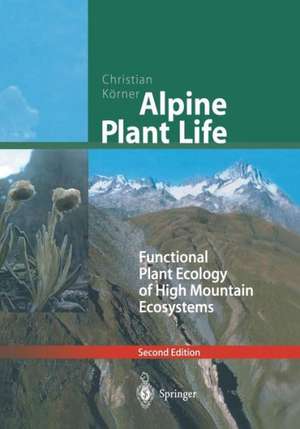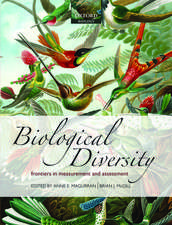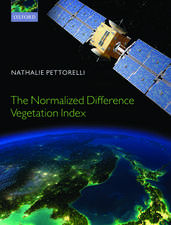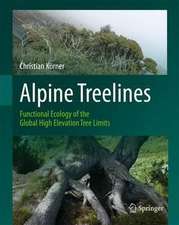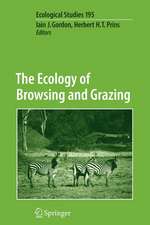Alpine Plant Life: Functional Plant Ecology of High Mountain Ecosystems
Autor Christian Körneren Limba Engleză Paperback – 22 aug 2014
This
second
edition
of
Alpine
Plant
Life
gives
new
references,
new
diagrams,
and
extensively
revised
chapters.
Toate formatele și edițiile
| Toate formatele și edițiile | Preț | Express |
|---|---|---|
| Paperback (2) | 435.39 lei 39-44 zile | |
| Springer International Publishing – 2 apr 2022 | 435.39 lei 39-44 zile | |
| Springer Berlin, Heidelberg – 22 aug 2014 | 436.18 lei 39-44 zile | |
| Hardback (2) | 579.55 lei 39-44 zile | +47.25 lei 7-13 zile |
| Springer International Publishing – apr 2021 | 636.09 lei 3-5 săpt. | +47.25 lei 7-13 zile |
| Springer Berlin, Heidelberg – 14 iul 2003 | 579.55 lei 39-44 zile |
Preț: 436.18 lei
Preț vechi: 538.49 lei
-19% Nou
Puncte Express: 654
Preț estimativ în valută:
83.47€ • 89.25$ • 69.59£
83.47€ • 89.25$ • 69.59£
Carte tipărită la comandă
Livrare economică 14-19 aprilie
Preluare comenzi: 021 569.72.76
Specificații
ISBN-13: 9783642189692
ISBN-10: 3642189695
Pagini: 364
Ilustrații: 4 Farbtaf., 243 Abb., 47 Tab.
Dimensiuni: 178 x 254 x 25 mm
Greutate: 0.63 kg
Ediția:2nd ed. 2003. Softcover reprint of the original 2nd ed. 2003
Editura: Springer Berlin, Heidelberg
Colecția Springer
Locul publicării:Berlin, Heidelberg, Germany
ISBN-10: 3642189695
Pagini: 364
Ilustrații: 4 Farbtaf., 243 Abb., 47 Tab.
Dimensiuni: 178 x 254 x 25 mm
Greutate: 0.63 kg
Ediția:2nd ed. 2003. Softcover reprint of the original 2nd ed. 2003
Editura: Springer Berlin, Heidelberg
Colecția Springer
Locul publicării:Berlin, Heidelberg, Germany
Public țintă
GraduateDescriere
Recent
years
have
seen
renewed
interest
in
the
fragile
alpine
biota.
The
International
Year
of
Mountains
in
2002
and
numerous
international
programs
and
initiatives
have
contributed
to
this.
Since
nearly
half
of
mankind
depends
on
water
supplies
originating
in
mountain
catchments,
the
integrity
and
functional
signi?cance
of
the
upland
biota
is
a
key
to
human
welfare
and
will
receive
even
more
attention
as
water
becomes
an
increasingly
limited
resource.
Intact
alpine
vegetation,as
the
safeguard
of
the
water
towers
of
the
world,
is
worth
being
well
understood.
This
new
edition
of
Alpine
Plant
Life
is
an
update
with
over
100
new
references,new
diagrams,
revised
and
extended
chapters
(particularly
7,
10,
11,
12,
16,
17)
and
now
also
offers
a
geographic
index.
My
thanks
go
to
the
many
careful
readers
of
the
?rst
edition
for
their
most
valuable
comments,
in
parti-
lar
to
Vicente
I.
Deltoro
(Valencia)
and
Johanna
Wagner
(Innsbruck).
Basel,April
2003
Christian
Körner
Preface
to
the
?rst
edition
One
of
the
largest
natural
biological
experiments,
perhaps
the
only
one
replicated
across
all
latitudes
and
all
climatic
regions,is
uplift
of
the
la-
scape
and
exposure
of
organisms
to
dramatic
climatic
gradients
over
a
very
short
distance,
otherwise
only
seen
over
thousands
ofkilometers
of
poleward
traveling.
Generations
of
plant
scientists
have
been
fascinated
by
these
natural
test
areas,and
have
explored
plant
and
ecosystem
responses
to
alpine
life
conditions.
Alpine
Plant
Life
is
an
attempt
at
a
synthesis.
Cuprins
1
Plant
ecology
at
high
elevations.-
The
concept
of
limitation.-
A
regional
and
historical
account.-
The
challenge
of
alpine
plant
research.-
2
The
alpine
life
zone.-
Altitudinal
boundaries.-
Global
alpine
land
area.-
Alpine
plant
diversity.-
Origin
of
alpine
floras.-
Alpine
growth
forms.-
3
Alpine
climate.-
Which
alpine
climate.-
Common
features
of
alpine
climates.-
Regional
features
of
alpine
climates.-
4
The
climate
plants
experience.-
Interactions
of
relief,
wind
and
sun.-
How
alpine
plants
influence
their
climate.-
The
geographic
variation
of
alpine
climate.-
5
Life
under
snow:
protection
and
limitation.-
Temperatures
under
snow.-
Solar
radiation
under
snow.-
Gas
concentrations
under
snow.-
Plant
responses
to
snowpack.-
6
Alpine
soils.-
Physics
of
alpine
soil
formation.-
The
organic
compound.-
The
interaction
of
organic
and
inorganic
compounds.-
7
Alpine
treelines.-
About
trees
and
lines.-
Current
altitudinal
positions
of
climatic
treelines.-
Treeline-climate
relationships.-
Intrazonal
variations
and
pantropical
plateauing
of
alpine
treelines.-
Treelines
in
the
past.-
Attempts
at
a
functional
explanation
of
treelines.-
A
hypothesis
for
treeline
formation.-
Growth
trends
near
treelines.-
Evidence
for
sink
limitation.-
8
Climatic
stress.-
Survival
of
low
temperature
extremes.-
Avoidance
and
tolerance
of
low
temperature
extremes.-
Heat
stress
in
alpine
plants.-
Ultraviolet
radiation
—
a
stress
factor.-
9
Water
relations.-
Ecosystem
water
balance.-
Soil
moisture
at
high
altitudes.-
Plant
water
relations
—
a
brief
review
of
principles.-
Water
relations
of
alpine
plants.-
Desiccation
stress.-
Water
relations
of
special
plant
types.-
10
Mineral
nutrition.-
Soil
nutrients.-
The
nutrient
status
of
alpine
plants.-
Nutrient
cycling
and
nutrient
budgets.-
Nitrogen
fixation.-
Mycorrhiza.-
Responses
of
vegetation
to
variable
nutrient
supply.-
11
Uptake
and
loss
of
carbon.-
Photosynthetic
capacity
of
alpine
plants.-
Photosynthetic
responses
to
the
environment.-
Daily
carbon
gain
of
leaves.-
The
seasonal
carbon
gain
of
leaves.-
C4
and
CAM
photosynthesis
at
high
altitudes.-
Tissue
respiration
of
alpine
plants.-
Ecosystem
carbon
balance.-
12
Carbon
investments.-
Non-structural
carbohydrates.-
Lipids
and
energy
content.-
Carbon
costs
of
leaves
and
roots.-
Whole
plant
carbon
allocation.-
13
Growth
dynamics
and
phenology.-
Seasonal
growth.-
Diurnal
leaf
extension.-
Rates
of
plant
dry
matter
accumulation.-
Functional
duration
of
leaves
and
roots.-
14
Cell
division
and
tissue
formation.-
Cell
size
and
plant
size.-
Mitosis
and
the
cell
cycle.-
From
meristem
activity
to
growth
control.-
15
Plant
biomass
production.-
The
structure
of
alpine
plant
canopies.-
Primary
productivity
of
alpine
vegetation.-
Plant
dry
matter
pools.-
Biomass
losses
through
herbivores.-
16
Plant
reproduction.-
Flowering
and
pollination.-
Seed
development
and
seed
size.-
Germination.-
Alpine
seed
banks
and
natural
recruitment.-
Clonal
propagation.-
Alpine
plant
age.-
Community
processes.-
17
Global
change
at
high
elevation.-
Alpine
land
use.-
The
impact
of
altered
atmospheric
chemistry.-
Climatic
change
and
alpine
ecosystems.-
References
(with
chapter
annotation).-
Taxonomic
index
(genera).-
Geographical
index.-
Color
plates.-
Plant
life
forms.-
The
alpine
life
zone.-
Environmental
stress.-
The
human
dimension.
Recenzii
"The
book
may
serve
not
only
as
an
excellent
reference
source
for
ecophysiological
topics,
but
also
as
a
source
of
fresh
ideas
and
inspiration
for
a
much
broader
readership."
(Leoš
Klimeš,
Folia
Geobotanica,
Vol.
41
(4),
2006)
" ... the best modern treatment of "functional ecology" of alpine plants that I have seen. ... this new edition added over 100 new references, new diagrams and revised and extended several chapters. ... an excellent summary and key to the study of plant-habitat relationships. ... should be a compulsory reading for every plant ecologist. In my library it is right next to the Larcher's Physiological Plant Ecology." (Botanical Electronic News)
"This is a fascinating synthesis on plant life at high altitude all around the world. There have been a number of studies on this topic, but the book by C. Körner is not just an addition to an already long list of publications. It attempts a synthesis based on a thorough functional analysis of the processes controlling plant life in these extreme situation, and on a broad overview of many of the mountain areaas around the world. ... It is also a very useful tool for ecophysiologists, because all the questions addressed are carefully analysed under the different relevant view points. ... In brief, this book is a model study for ecologists and ecophysiologists." (Annals of Forest Science)
"Alpine Plant Life proved to be the right book for those who are either advanced gardeners or for those with scientific interests in the alpine ecosystems. This book is divided into 17 chapters beginning with the discussion of "Plant Ecology at High Elevations" and ending with an excellent discussion of "Global Change at High Elevation". … Several color plates supplement the black and white photographs included throughout the book." (Diana Pederson, BellaOnline's Environment, June, 2004)
"Korner, a renowned alpine ecophysiologist, synthesizes the accumulated knowledge of generations of alpine life scientists in this encyclopedic book. Introduces the alpine plant zone … . Examines the interation between plant, wind … . Discusses the physics of alpine soil … . Reviews the uptake and loss of carbon … . Analyses plant growth function, cell division … . Extensively referenced, 218 figures, 4 color plates, and 47 tables. For ecologists and ecology students." (Northeastern Naturalist, Vol. 11(3), 2004)
"This book is the best modern treatment of ‘functional ecology’ of alpine plants that I have seen. The new edition, in hard copy book, costs less … . At the same time, this new edition added over … . This book is an excellent summary and key to the study of plant-habitat relationships. The Alpine Plant Life by Christian Koerner should be a compulsory (sic) reading for every plant ecologist." (Adolf Ceska, Botanical Electronic News, September 2004)
"The second edition has been revised, updated and enlarged. … very clearly structured presentations of examples, discussions of arguments … . As a result, the reader is not left alone with a wealth of details; rather, he/she becomes guided … . In summary, Körner’s "Alpine Plant Life" is an overview and manual for the scene, and will be a must for every scientific library. Moreover, it is very useful for the private book shelf for everybody who is engaged in research … ." (Rainer Lösch, Phytocoenologia, Vol. 34(4), 2004)
"This is a fascinating synthesis on plant life at high altitude all around the world. … is not just an addition to an already long list of publication. … It is also a very useful tool for ecophysiologists, because all the questions addressed are carefully analysed under the different relevant view points. … As such, it is a nice illustration of the way ecophysiological thinking may proceed. The best example … . In brief, this book is a model study for ecologists and ecophysiologists." (Erwin Dreyer, Annals of Forest Science, Vol. 61(5), 2004)
"... a welcome second edition. ... It is a superb textbook – well written with plenty of good quality photographs, graphs and diagrams. It hits a happy compromise in being accessible to novices in upland areas and/or plants but with sufficient depth to leave the reader feeling that they have got to grips with the topic. The book starts with reviews of alpine life zones, climate, soils … . A superb textbook that should be read and used by all ecology students."(Bulletin of the British Ecological Society, Vol. 35(1), 2004)
" ... the best modern treatment of "functional ecology" of alpine plants that I have seen. ... this new edition added over 100 new references, new diagrams and revised and extended several chapters. ... an excellent summary and key to the study of plant-habitat relationships. ... should be a compulsory reading for every plant ecologist. In my library it is right next to the Larcher's Physiological Plant Ecology." (Botanical Electronic News)
"This is a fascinating synthesis on plant life at high altitude all around the world. There have been a number of studies on this topic, but the book by C. Körner is not just an addition to an already long list of publications. It attempts a synthesis based on a thorough functional analysis of the processes controlling plant life in these extreme situation, and on a broad overview of many of the mountain areaas around the world. ... It is also a very useful tool for ecophysiologists, because all the questions addressed are carefully analysed under the different relevant view points. ... In brief, this book is a model study for ecologists and ecophysiologists." (Annals of Forest Science)
"Alpine Plant Life proved to be the right book for those who are either advanced gardeners or for those with scientific interests in the alpine ecosystems. This book is divided into 17 chapters beginning with the discussion of "Plant Ecology at High Elevations" and ending with an excellent discussion of "Global Change at High Elevation". … Several color plates supplement the black and white photographs included throughout the book." (Diana Pederson, BellaOnline's Environment, June, 2004)
"Korner, a renowned alpine ecophysiologist, synthesizes the accumulated knowledge of generations of alpine life scientists in this encyclopedic book. Introduces the alpine plant zone … . Examines the interation between plant, wind … . Discusses the physics of alpine soil … . Reviews the uptake and loss of carbon … . Analyses plant growth function, cell division … . Extensively referenced, 218 figures, 4 color plates, and 47 tables. For ecologists and ecology students." (Northeastern Naturalist, Vol. 11(3), 2004)
"This book is the best modern treatment of ‘functional ecology’ of alpine plants that I have seen. The new edition, in hard copy book, costs less … . At the same time, this new edition added over … . This book is an excellent summary and key to the study of plant-habitat relationships. The Alpine Plant Life by Christian Koerner should be a compulsory (sic) reading for every plant ecologist." (Adolf Ceska, Botanical Electronic News, September 2004)
"The second edition has been revised, updated and enlarged. … very clearly structured presentations of examples, discussions of arguments … . As a result, the reader is not left alone with a wealth of details; rather, he/she becomes guided … . In summary, Körner’s "Alpine Plant Life" is an overview and manual for the scene, and will be a must for every scientific library. Moreover, it is very useful for the private book shelf for everybody who is engaged in research … ." (Rainer Lösch, Phytocoenologia, Vol. 34(4), 2004)
"This is a fascinating synthesis on plant life at high altitude all around the world. … is not just an addition to an already long list of publication. … It is also a very useful tool for ecophysiologists, because all the questions addressed are carefully analysed under the different relevant view points. … As such, it is a nice illustration of the way ecophysiological thinking may proceed. The best example … . In brief, this book is a model study for ecologists and ecophysiologists." (Erwin Dreyer, Annals of Forest Science, Vol. 61(5), 2004)
"... a welcome second edition. ... It is a superb textbook – well written with plenty of good quality photographs, graphs and diagrams. It hits a happy compromise in being accessible to novices in upland areas and/or plants but with sufficient depth to leave the reader feeling that they have got to grips with the topic. The book starts with reviews of alpine life zones, climate, soils … . A superb textbook that should be read and used by all ecology students."(Bulletin of the British Ecological Society, Vol. 35(1), 2004)
Notă biografică
Christian Körner was born in 1949 in Austria, received his academic education at the University of Innsbruck, and was full professor of Botany at the University of Basel from 1989 to 2014. As emeritus Professor he is continuing alpine plant research in the Swiss Alps.
Textul de pe ultima copertă
This book is a completely revised, substantially extended treatment of the physical and biological factors that drive life in high mountains. The book covers the characteristics of alpine plant life, alpine climate and soils, life under snow, stress tolerance, treeline ecology, plant water, carbon, and nutrient relations, plant growth and productivity, developmental processes, and two largely novel chapters on alpine plant reproduction and global change biology. The book explains why the topography driven exposure of plants to dramatic micro-climatic gradients over very short distances causes alpine biodiversity to be particularly robust against climatic change. Geographically, this book draws on examples from all parts of the world, including the tropics. This book is complemented with novel evidence and insight that emerged over the last 17 years of alpine plant research. The number of figures – mostly in color – nearly doubled, with many photographs providing a vivid impression of alpine plant life worldwide.
Christian Körner was born in 1949 in Austria, received his academic education at the University of Innsbruck, and was full professor of Botany at the University of Basel from 1989 to 2014. As emeritus Professor he is continuing alpine plant research in the Swiss Alps.
Caracteristici
Presents a unique and comprehensive treatment of plant ecology in high mountain regions of all parts of the world Is the fully revised third edition of this successful textbook Contains many photographs and line drawings, most of them in color
